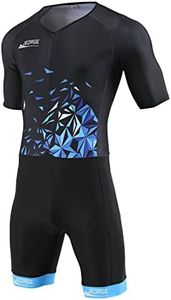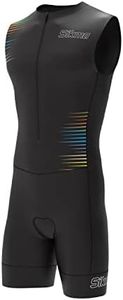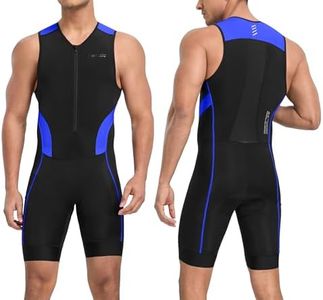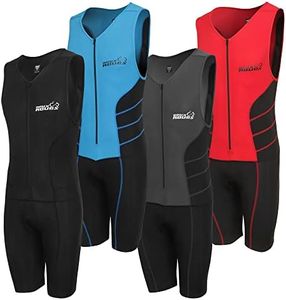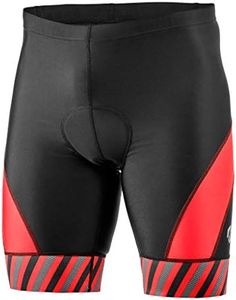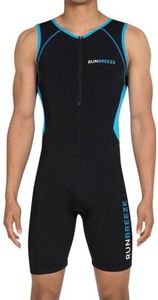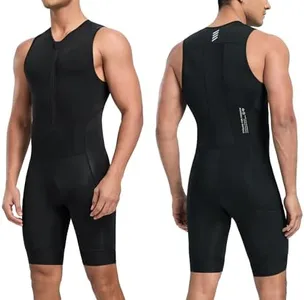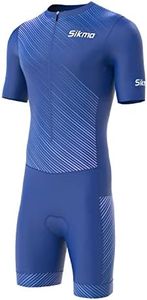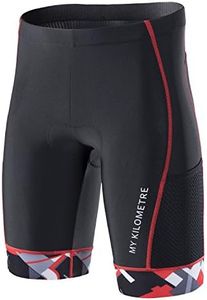We Use CookiesWe use cookies to enhance the security, performance,
functionality and for analytical and promotional activities. By continuing to browse this site you
are agreeing to our privacy policy
10 Best Tri Suit For Men
From leading brands and best sellers available on the web.Buying Guide for the Best Tri Suit For Men
Picking the right tri-suit for men is important to ensure comfort, performance, and ease during a triathlon. A tri-suit is designed for use in all three disciplines—swimming, cycling, and running—so you don’t have to change outfits during transitions. The right choice will enhance your performance, minimize discomfort, and help you focus on the race. When deciding, think about how often you participate in triathlons and what distances you usually compete at. Always try to prioritize fit, comfort, and features that suit your racing needs.Fit and MaterialThe fit of a tri-suit should be snug but not restrictive—it needs to feel like a second skin. This is important because a suit that's too loose can create drag while swimming and bunch up during cycling or running. The material typically blends spandex or lycra for stretch and polyester or nylon for durability and moisture management. Suits that are too tight may restrict movement and cause discomfort. Standard fits range from 'race-fit' (very tight), which favors speed and aerodynamics, to 'club-fit' (slightly more relaxed). If you’re aiming for personal bests or top performance, a closer fit is ideal, while beginners or those prioritizing comfort may prefer a slightly looser cut.
Chamois (Padding)The chamois is the padded section in the crotch area designed to make the cycling portion more comfortable. The key is that it must be thin enough not to feel bulky during running or swimming, but still provide enough protection for the bike leg. Minimalist pads are common in short course suits, while slightly thicker ones may be found in long course suits. If your races are short or you don’t mind a bit less padding, opt for a minimal chamois. For longer distances or more cycling comfort, look for a suit with a slightly thicker (but still flexible) pad.
Leg Grippers and Arm BandsLeg grippers and arm bands help keep the suit in place, preventing it from riding up or chafing during the race. Grippers range from silicone bands to textured fabrics, each with a different feel—some are more secure, others are gentler on the skin. For intense racing or if you’re prone to suit shifting, more pronounced grippers may be best. If you have sensitive skin, softer, fabric-based grippers might be preferable.
ZippersMost tri-suits feature a zipper, typically on the front, to help put on the suit and provide ventilation. The length and position of the zipper matter—longer zippers allow for more airflow and easier changes, but shorter ones can reduce drag and chafing potential. Choose a suit with a zipper length and position that matches your comfort with opening/closing it on the go and your preference for ventilation versus water drag during the swim.
PocketsPockets in a tri-suit allow you to carry nutrition, keys, or other essentials during your race. The number and placement of pockets can vary. For longer races, more pockets or larger pockets can be helpful to store gels or bars. For sprint or short-course events, you might need fewer or no pockets to avoid extra drag. Think about how much you typically carry—let that guide your choice.
Sleeve Length and CoverageTri-suits come in sleeveless, short-sleeve, and sometimes even longer-sleeve versions. Sleeves can offer better sun protection and aerodynamics, while sleeveless suits allow for more freedom of movement and are often cooler in hot weather. Choose sleeve length based on your environment and comfort: if you race in sunny or cooler conditions and want more coverage, sleeves are a plus. If you prefer maximum mobility or race in hot weather, go sleeveless.
